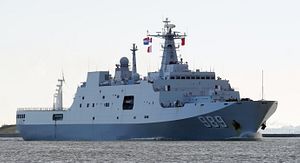Within the next decade, China will likely wield a weapon of political influence that thus far only the United States has fully taken advantage of. In a recent Asia Times article, Grant Newsham wrote of the political and military implications of China’s growing fleet of amphibious warfare vessels. Newsham argued that the primary impact of China’s fleet will come through its political implications, rather than through its use as a weapon of war. The more important consideration is how this fleet will allow China to maximize and extend its influence across the Indo-Pacific region.
As The Diplomat’s Rick Joe suggests, by 2025 China will have at least three Type 075 LHDs in service, and could have as many as eight in service by 2030. As Joe indicates, the PLAN will shortly have eight Type 071 LPDs available, although it is unclear how many more of these ships should be expected. U.S. Navy experience with LPDs has no clear lessons for the future of the LHA force, although the USN eventually expects to acquire 26 San Antonio-class LPDs in support of roughly a dozen LHAs.
Much of the discussion of China’s amphibious assault fleet has focused on the role that it might play in high and medium intensity operations, the latter including the seizure of islands controlled by Japan, the Philippines, or Vietnam, and the former a full-scale invasion of Taiwan. These amphibious assault ships and their LPD support force could enable China to seize territory and render a fait accompli against an unfortunate neighbor.
For its part, the United States Navy has wielded its amphibious force as a weapon of global political influence. This has included both humanitarian and disaster relief operations (following the 2004 tsunami), and operations for consequential military effect, such as in the campaign to depose Libyan dictator Muammar Gaddafi. This combination of high and low intensity capabilities (the high intensity representing both the ability to make contested landings and the intrinsic air warfare capability of a flat topped ship) makes the amphibious fleet a particularly attractive choice for navies of all sizes.
There’s some indication that China is thinking in explicitly political terms regarding the utility of its own “gator navy.” For example, the film Operation Red Sea depicts a Chinese expeditionary force deploying into a North African country and rescuing hostages from terrorist organizations. Given the close cooperation that filmmakers had with the PLAN, this suggests the value that the PLAN places on the capacity to undertake expeditionary operations, even those that do not rise to the level of war. Operation Red Sea is a movie, of course, and does not describe PLAN doctrine. However, it does give some indication as to how the PLAN wants the Chinese (and international) public to anticipate the force of the future.
Of course, China’s new amphibs are hardly the only game in town. Australia, Japan, South Korea, and several other navies across the region have procured amphibs. The experience of the 2004 tsunami seems to have driven much of the interest in the type across the region. But only China is building a fleet capable of eventually rivaling that of the United States Navy.

































